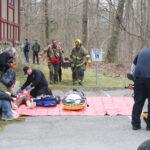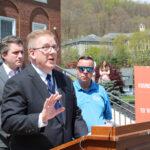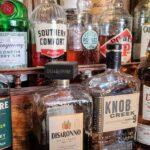The hearing was well-attended
POUGHKEEPSIE – Locals concerned about the ongoing issue of contamination in the Hudson River spoke out to Environmental Protection Agency officials at a public hearing Wednesday night.
Representatives of Scenic Hudson, Riverkeeper and local government officials were among those who had their voices heard at the Poughkeepsie Grand Hotel regarding the EPA’s progress on PCB-contaminated sediment cleanup. The agency recently completed its second five-year review on the matter, and a panel presented their findings to the public before taking questions.
“[The EPA] has not yet recognized that we want a complete cleanup,” said Scenic Hudson President Ned Sullivan.
“General Electric has conducted an extensive cleanup in the upper Hudson, but they left thousands of pounds of PCBs behind, Superfund caliber contaminants, meaning the most hazardous waste in the country. Those are still in the upper Hudson and they are flowing over the Troy dam and contaminating the lower Hudson,” Sullivan said. “Our fish are not safe to eat, our drinking water is threatened; our air is unsafe. It’s time for a complete and comprehensive cleanup.”
“People aren’t patient,” said Richard Webster, the legal program director for Riverkeeper. “They really want to see a cleanup of the Hudson, and they want to see it as soon as possible.”
Gary Klawinski, the EPA’s field office director for the Hudson River, led the panel of five EPA officials as they broke down the crucial points in the report.
The point that garnered fevered reaction was the prediction that in about 15 years, people would only be able to eat one fish meal every two months, due to the slow recovery of the fish in the river from contaminants. Additionally, it will be more than 55 years before all local species of fish are clean enough for some people to eat once a week.
“The PCBs are spread out in a huge area of 200 miles,” Klawinski said. “It’s not feasible to take all those PCBs out, unfortunately.”
Klawinski pointed out that this prediction has been consistent with what was postulated back in 2002, when the EPA initiated clean-up by dredging PCBs from the river, but there is a slight discrepancy. Since the dredging stopped in 2015, a year’s worth of data is missing from the official five-year review, he explained.
Other concerns raised included the cleanup efforts of General Electric, which instigated the pollution of the river, and the fact that the EPA underestimated how much contamination is in the river in its initial estimate.
Statements were also read from representatives of state lawmakers, who were all absent due to a special session called by the governor.
Westchester County Executive Chief of Staff Philip Oliva offered his thoughts on the ongoing problem said the PCB situation is a bipartisan issue. “People want a clean river; they want to be able to eat the fish,” Oliva said. “I think there has been progress made, but we don’t want to stop halfway through.”
General Electric dispensed PCBs into the Hudson River from 1947-1977, which inspired an onslaught of activism, most notably from musician Pete Seeger and his organization, Hudson River Sloop Clearwater. Superfund now oversees a 200-mile stretch of the river, and the EPA commissioned its dredging project in 2001 after studying the river for 10 years. As part of its efforts, the EPA ordered GE to clean up a part of the river it had contaminated.







